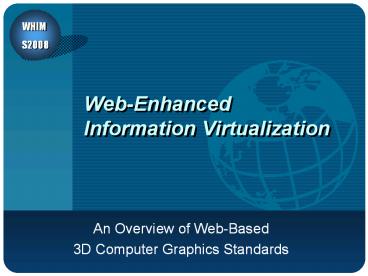Web-Enhanced Information Virtualization - PowerPoint PPT Presentation
1 / 14
Title: Web-Enhanced Information Virtualization
1
Web-EnhancedInformation Virtualization
WHIM S2008
- An Overview of Web-Based
- 3D Computer Graphics Standards
2
Why do we need it
- Encapsulate computing resources from the user
- Provide a simplified interface to enhance
usability
3
2D vs. 3D
- Decade-long debate
- 2D Takes less power to compute, easier to
encode and transmit - But generally less expressive and
compelling, viewer perspective limited by
the dimension to the creators own - 3D More difficult to model
- But easier to manipulate from multiple
perspectives and animate more realistic
motions.
4
Standard Artifact VRML
- Virtual Reality Modeling Language, originally
named as VR Markup Language - A standard for presenting 3D interactive vector
graphics - Designed for WWW context
5
Format of VRML
- Uses text to describe vertices and edges of 3D
polygons, along with the texture information
(mapping, surface color, shininess, etc). - URL can be associated with any graphical
component - Aspects of the virtual world (lighting, sounds,
etc) can be included in the world file (.wrl) to
interact with the user or external events - Support embedded Java or JavaScript code for
event-handling.
6
Code Segment of a VRML file
- VRML V2.0 utf8
- WorldInfo
- title Just a sample
- info for Apr.29 WHIM presentation"
ks2555_at_columbia.com" - Transform
- translation 0 2.25 0
- children
- Shape
- appearance Appearance
- texture ImageTexture url "me.jpg"
- geometry Sphere radius 0.75
7
History of VRML
- Birth First proposed in a paper submitted to the
First International Conference on World Wide Web - Popularization Revamped as VRML 97 established
as an ISO standard became widely used,
particularly for education and research area.
CyberTown.coms 3D chat application developped by
Blaxxun Software in VRML97 standard
8
History of VRML
- Criticism
- VRML was born dead. It never solved any real
problems. Good riddance. - --Clay Shirky, on the WWW Artist Consortium
mailing list - No integration with HTML, They were too busy
getting the 3D to work. - --Chris Phillips, director of business
development and multimedia at Microsoft - Central idea of these criticism is VRML gets
the job done on 3D part, but its spec is locked,
thus there is no easy way to integrate or extend
it.
9
X3D
- The successor of VRML, from Web3D Consortium
- XML-Based
- First approved by ISO in 2004
- Defines several sets of extensions for different
purposes - Core set
- Interchange
- CAD
- Geospatial
- Immersive
- Browser makers can define their own extensions
and submit to Web3DC for standardization
10
X3Ds Improvement over VRML
Multiple data encodings
New graphics features
New networking features
Improved APIs, more language/object model bindings
Modularity
MPEG-4 has streaming interactive 3D using VRML
11
Interaction Model
Add Your Text
Text
Text
Cycle name
Text
Text
Text
12
Data Encoded in X3D
- Sample Java Applet 3D Model Viewer embedded in
the html page
13
Development Enviorment
- Xj3D a Java based developer X3D Toolkit and
browser for data modelled in X3D
14
Conclusion
- X3D is a relative junior standard
- There are some other competing standards (e.g.
COLLADA) alternative to X3D - X3Ds promising for 3D Web Publishing, durability
and full potential yet to be seen































